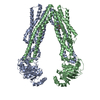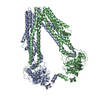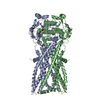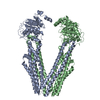+ Open data
Open data
- Basic information
Basic information
| Entry | Database: PDB / ID: 9gsj | |||||||||||||||||||||||||||
|---|---|---|---|---|---|---|---|---|---|---|---|---|---|---|---|---|---|---|---|---|---|---|---|---|---|---|---|---|
| Title | BmrA E504A in complex with Hoechst33342 | |||||||||||||||||||||||||||
 Components Components | Multidrug resistance ABC transporter ATP-binding/permease protein BmrA | |||||||||||||||||||||||||||
 Keywords Keywords | MEMBRANE PROTEIN / transporter complex with Hoechst33342 | |||||||||||||||||||||||||||
| Function / homology |  Function and homology information Function and homology informationATPase-coupled lipid transmembrane transporter activity / Translocases; Catalysing the translocation of other compounds; Linked to the hydrolysis of a nucleoside triphosphate / ABC-type transporter activity / transmembrane transport / response to antibiotic / ATP hydrolysis activity / ATP binding / plasma membrane Similarity search - Function | |||||||||||||||||||||||||||
| Biological species |  | |||||||||||||||||||||||||||
| Method | ELECTRON MICROSCOPY / single particle reconstruction / cryo EM / Resolution: 3.6 Å | |||||||||||||||||||||||||||
 Authors Authors | Moissonnier, L. / Zarkadas, E. / Schoehn, G. / Falson, P. / Chaptal, V. | |||||||||||||||||||||||||||
| Funding support |  France, 2items France, 2items
| |||||||||||||||||||||||||||
 Citation Citation |  Journal: Nat Commun / Year: 2025 Journal: Nat Commun / Year: 2025Title: Rhodamine6G and Hœchst33342 narrow BmrA conformational spectrum for a more efficient use of ATP. Authors: A Gobet / L Moissonnier / E Zarkadas / S Magnard / E Bettler / J Martin / R Terreux / G Schoehn / C Orelle / J M Jault / P Falson / V Chaptal /   Abstract: Multidrug ABC transporters harness the energy of ATP binding and hydrolysis to translocate substrates out of the cell and detoxify them. While this involves a well-accepted alternating access ...Multidrug ABC transporters harness the energy of ATP binding and hydrolysis to translocate substrates out of the cell and detoxify them. While this involves a well-accepted alternating access mechanism, molecular details of this interplay are still elusive. Rhodamine6G binding on a catalytic inactive mutant of the homodimeric multidrug ABC transporter BmrA triggers a cooperative binding of ATP on the two identical nucleotide-binding-sites, otherwise michaelian. Here, we investigate this asymmetric behavior via a structural-enzymology approach, solving cryoEM structures of BmrA at defined ATP ratios, highlighting the plasticity of BmrA as it undergoes the transition from inward to outward facing conformations. Analysis of continuous heterogeneity within cryoEM data and structural dynamics, reveals that Rhodamine6G narrows the conformational spectrum explored by the nucleotide-binding domains. We observe the same behavior for the other drug Hœchst33342. Following on these findings, the effect of drug-binding showed an ATPase stimulation and a maximal transport activity of the wild-type protein at the concentration-range where the cooperative transition occurs. Altogether, these findings provide a description of the influence of drug binding on the ATP-binding sites through a change in conformational dynamics. | |||||||||||||||||||||||||||
| History |
|
- Structure visualization
Structure visualization
| Structure viewer | Molecule:  Molmil Molmil Jmol/JSmol Jmol/JSmol |
|---|
- Downloads & links
Downloads & links
- Download
Download
| PDBx/mmCIF format |  9gsj.cif.gz 9gsj.cif.gz | 204.1 KB | Display |  PDBx/mmCIF format PDBx/mmCIF format |
|---|---|---|---|---|
| PDB format |  pdb9gsj.ent.gz pdb9gsj.ent.gz | 162.5 KB | Display |  PDB format PDB format |
| PDBx/mmJSON format |  9gsj.json.gz 9gsj.json.gz | Tree view |  PDBx/mmJSON format PDBx/mmJSON format | |
| Others |  Other downloads Other downloads |
-Validation report
| Summary document |  9gsj_validation.pdf.gz 9gsj_validation.pdf.gz | 1.3 MB | Display |  wwPDB validaton report wwPDB validaton report |
|---|---|---|---|---|
| Full document |  9gsj_full_validation.pdf.gz 9gsj_full_validation.pdf.gz | 1.3 MB | Display | |
| Data in XML |  9gsj_validation.xml.gz 9gsj_validation.xml.gz | 46.6 KB | Display | |
| Data in CIF |  9gsj_validation.cif.gz 9gsj_validation.cif.gz | 70.4 KB | Display | |
| Arichive directory |  https://data.pdbj.org/pub/pdb/validation_reports/gs/9gsj https://data.pdbj.org/pub/pdb/validation_reports/gs/9gsj ftp://data.pdbj.org/pub/pdb/validation_reports/gs/9gsj ftp://data.pdbj.org/pub/pdb/validation_reports/gs/9gsj | HTTPS FTP |
-Related structure data
| Related structure data |  51550MC  8rezC  8rf1C  8rg7C  8rgaC  8rgnC  8ri1C  8riaC C: citing same article ( M: map data used to model this data |
|---|---|
| Similar structure data | Similarity search - Function & homology  F&H Search F&H Search |
- Links
Links
- Assembly
Assembly
| Deposited unit | 
|
|---|---|
| 1 |
|
- Components
Components
| #1: Protein | Mass: 65747.141 Da / Num. of mol.: 2 / Mutation: E504A Source method: isolated from a genetically manipulated source Source: (gene. exp.)   #2: Chemical | Has ligand of interest | Y | Has protein modification | N | |
|---|
-Experimental details
-Experiment
| Experiment | Method: ELECTRON MICROSCOPY |
|---|---|
| EM experiment | Aggregation state: PARTICLE / 3D reconstruction method: single particle reconstruction |
- Sample preparation
Sample preparation
| Component | Name: BmrA E504A in complex with Hoechst33342 / Type: COMPLEX / Entity ID: #1 / Source: RECOMBINANT |
|---|---|
| Molecular weight | Value: 0.13 MDa / Experimental value: NO |
| Source (natural) | Organism:  |
| Source (recombinant) | Organism:  |
| Buffer solution | pH: 7.5 |
| Specimen | Conc.: 4 mg/ml / Embedding applied: NO / Shadowing applied: NO / Staining applied: NO / Vitrification applied: YES / Details: Membrane protein in detergent |
| Specimen support | Grid material: GOLD / Grid mesh size: 300 divisions/in. / Grid type: Quantifoil |
| Vitrification | Instrument: FEI VITROBOT MARK IV / Cryogen name: ETHANE / Humidity: 100 % / Chamber temperature: 298 K |
- Electron microscopy imaging
Electron microscopy imaging
| Experimental equipment |  Model: Titan Krios / Image courtesy: FEI Company |
|---|---|
| Microscopy | Model: FEI TITAN KRIOS |
| Electron gun | Electron source:  FIELD EMISSION GUN / Accelerating voltage: 300 kV / Illumination mode: OTHER FIELD EMISSION GUN / Accelerating voltage: 300 kV / Illumination mode: OTHER |
| Electron lens | Mode: BRIGHT FIELD / Nominal defocus max: 2400 nm / Nominal defocus min: 1000 nm |
| Image recording | Electron dose: 49.6 e/Å2 / Film or detector model: GATAN K3 (6k x 4k) |
- Processing
Processing
| EM software |
| ||||||||||||||||||||||||
|---|---|---|---|---|---|---|---|---|---|---|---|---|---|---|---|---|---|---|---|---|---|---|---|---|---|
| CTF correction | Type: PHASE FLIPPING AND AMPLITUDE CORRECTION | ||||||||||||||||||||||||
| Symmetry | Point symmetry: C1 (asymmetric) | ||||||||||||||||||||||||
| 3D reconstruction | Resolution: 3.6 Å / Resolution method: FSC 0.143 CUT-OFF / Num. of particles: 890304 / Symmetry type: POINT | ||||||||||||||||||||||||
| Refine LS restraints |
|
 Movie
Movie Controller
Controller










 PDBj
PDBj



